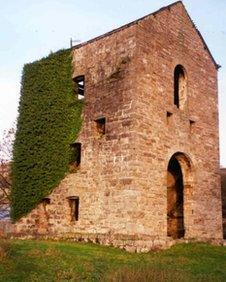Historic Clive Engine House to be restored
- Published

Clive Engine House pumped water out of a mine in Dyserth in the 1800s
A 19th Century engine building used to pump water out of a Denbighshire mine is being restored.
Clive Engine House has stood unused for more than 120 years after serving Talargoch Mine in Dyserth until 1884.
Now county archaeologists have secured funds to repair the building, which has been affected by weathering over the decades.
It was opened to the public on Friday to show how work is progressing.
Denbighshire council archaeologist Fiona Gale said: "It was a fantastic, once in a lifetime opportunity to repair the building and bring it back into good order".
Built in 1860, the Cornish engine house was home to a steam cylinder which powered water extraction pumps.
Lead extraction is thought to have taken place at Talargoch since the Roman period.
It has also produced copper, silver and calamine, but it is most famous as a producer of lead and zinc ore.
The engine house is one of the few remaining signs of what was once a large and important industry in the area.
The engine was in operation until the mine closed in 1884 when the engine was sold to the former Westminster Colliery in Wrexham.
David Thomas, the Denbighshire cabinet lead member for regeneration, said the building was a "testament to the hard work of all those who worked in the lead mines in the area over many years".
Grants from funders WREN and Cadw are paying for repair work which is being co-ordinated by Denbighshire council.
- Published16 December 2011
- Published2 December 2011